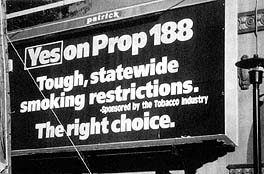The Stealth Campaign
After the initiative qualified, CSSR avoided the media and public debates on the initiative and instead began an expensive direct mail advertising campaign to reach voters. Proposition 188 was promoted as a tobacco control law, a tough but reasonable alternative to AB 13. Although virtually all the money for Proposition 188 was coming from the tobacco industry (table 3), CSSR downplayed the industry's role in the campaign and, in typical fashion, presented itself as a coalition of small business owners, restaurants, and concerned California citizens.
Lee Stitzenberger of the Dolphin Group ran the campaign for Philip
It calls for no television, 15 m pieces of mail, the ol' slate-card extortion, earned media, some newspaper ads, and a couple of weeks of radio at the end. Basically, it is a kind of stealth campaign: much of it will fly under radar cover. The first phase of the campaign, between now and Labor Day, will hit the sponsorship head on. “If you think this is a ploy by the tobacco companies, read the proposal. Here it is. Read it.” The next phase will attempt to use allies, broaden the base with coalitions, and the use of spokespeople for earned media. The final phase will be targeted radio and the slates.
The primary message, other than “we don't have anything to hide,” will be that AB 13 goes too far, we need severe restrictions, not bans. The other side won't have any money, but they will have almost universal editorial support. The campaign will monitor their use of Prop 99 monies and is prepared to challenge any use thereof in court.
They [CSSR] have a $9 m budget for the remainder of the campaign. We guess PM has put about $1.5 [m] in so far. Ellen [Merlo] said that PM has budgeted $6 m, so they are looking for $3 [m] from the rest of the industry. In addition, National Smoker Alliance will do two statewide smoker mailing [s] (which, of course, PM will pay for)… .
What they want from the rest of the industry, in addition to $3,000,000, is the use of some of our outdoor boards, help with point-of-sale distribution, smoker lists, and spokespeople (such as Danny Glover).
We speculate that PM is interested in full industry participation for reasons beyond money. We suspect they want to share the negative pr this effort is taking in the media and among elected officials.
Lee said that there is not a 50-50 chance that we will win this, but it isn't far off. Their main point (and that of the entire California team, including O'Mally) was that this is the only chance we have of making progress in that state.[111] [emphasis added]
The CSSR attempted to present Proposition 188 as an anti-smoking measure. In doing so, the organization departed from previous tobacco industry election campaigns by emphasizing anti-tobacco themes: limiting youth access to tobacco, protection of nonsmokers, and accommodation (figure 14).
Yet Proposition 188 represented a rollback of existing California tobacco control laws. Philip Morris used the industry's usual rhetoric only in emphasizing that restrictions on tobacco represented unwarranted government intrusion into people's private lives; targeted mailings to its National Smokers' Alliance and other smokers' rights lists portrayed Proposition 188 as a chance to “preserve your right to smoke.”[112]

Figure 14. Tobacco industry billboard promoting Proposition 188 as a “tough” anti-smoking measure. The statement “Sponsored by the Tobacco Industry” was added by a graffiti artist. As originally displayed, the billboard did not disclose who was financing the campaign. (Photo courtesy of Julie Carol, Americans for Nonsmokers' Rights)